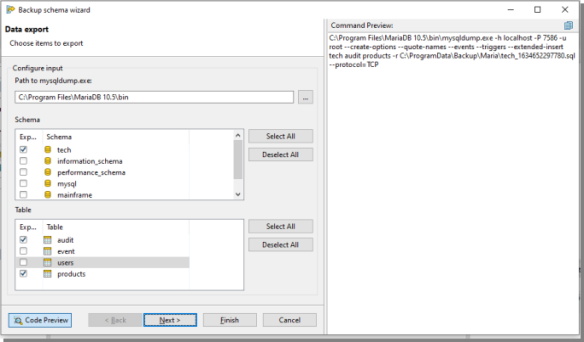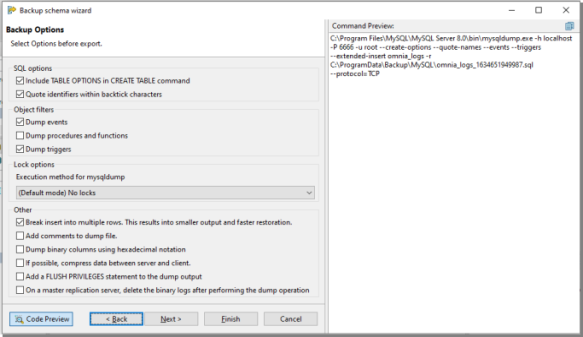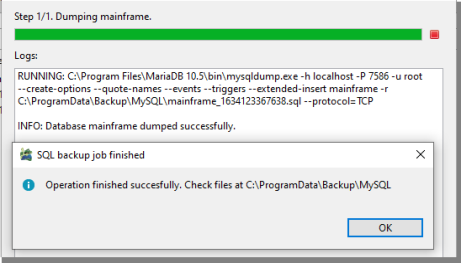Continuous Integration and Delivery Wizard
The CI/CD Wizard guides you through the process of creating and customizing various build steps. It saves you the hassle of having to manually write a script with appropriate arguments to use with the Toad Edge® command line interface.
The generated script can be viewed at any time in the wizard by clicking the Command Preview button.

The following table lists all currently available build steps and files/configuration required to export them.
| Empty database |
- Database connection file (XML)
|
Runs a query that drops all objects in the selected database |
| Create snapshot |
- Database connection (XML file)
|
Stores the structure (not data) of the selected database as a JSON file. The Snapshotscan be used as a backup |
| Create baseline |
- Database connection (XML file)
|
Stores the structure (not data) of the selected database as a JSON file. This snapshot can be used as a backup or as a baseline for the Compare database with baseline build step |
| Generate create SQL script |
One of the following:
- Database connection (XML file)
- Repository (folder structure)
- Snapshot (JSON file)
|
Generates a create SQL script from a repository, saved snapshot or a database. The script can be used to recreate the structure of the source (not data) |
| Generate change SQL script |
- Schema Compare result (folder with JSON files)
|
Generates a change SQL script to deploy changes to the Schema Compare target based on differences found in the previously run Compare database schemas build step |
| Compare database schemas |
- Recent Schema Compare
- Saved Schema Compare (.compare file)
Or two of the following:
- Database connection (XML file)
- Repository (folder structure)
- Snapshot (JSON file)
|
Compares two different schemas (from databases, repositories or snapshots). The results are stored in a folder that can be used as an input for other build steps |
| Compare database with baseline |
One of the following:
- Database connection (XML file)
- Repository (folder structure)
- Snapshot (JSON file)
And also a baseline snapshot (JSON file) |
Compares the given database with the given baseline snapshot. In case any differences are found, an error is raised and the build step will fail |
| Deploy SQL script |
- Database connection (XML file)
- Input SQL file
|
Runs any SQL script on a selected database |
| Generate HTML comparison report |
- Schema Compare result (folder with JSON files)
|
Generates an HTML report based on the results of the previously run Compare database schemas build step |
Toad Edge® command line interface
|

|
IMPORTANT: To execute build steps correctly, Toad Edge requires a 64-bit installation of Java Development Kit (JDK), however, 32-bit Java is usually used by default. It is therefore necessary to create a JAVA_HOME system variable pointing at 64-bit JDK directory.
Please do the following steps to perform the configuration:
- Right-click This PC and select Properties | Advanced System Settings | Environment Variables
- Click New in System Variables
- In the Variable Name field, enter JAVA_HOME
- In the Variable Value field, enter your JDK installation path, e.g. C:\Progra~1\Java\jdk-11.0.1
|
|

|
NOTE: Toad Edge CLI works for JDK >= 11. The CLI has been tested with JDK 11. |
The core Continuous Integration and Delivery (CI/CD) functionality in Toad Edge is provided by its command line interface (CLI). Although the best way to use it is to use the CI/CD Wizard, you can also work with it manually.
To use Toad Edge CLI manually
- Download a zip archive containing Toad Edge JAR file and other libraries from here
- Extract the archive
- Launch the command line utility (Windows) or the terminal (Linux) and navigate to the folder with the JAR file
- Execute the JAR file with Java command and additional arguments
Every usable command begins with java -jar toadedge.jar followed by the operation you want to perform and additional arguments.
The available operation arguments correspond to the build steps available in the CI/CD Wizard:
- -compare
- -report
- -sql_change
- -sql_create
- -deploy
- -snapshot
- -baseline
The operation argument has to be followed by other arguments specifying input, output, settings, etc. To learn which arguments you need to use to perform a specific operation, add the -help argument at the end of your command.

Once you supply all the necessary arguments, you can start performing CI/CD actions without having to launch Toad Edge itself.

This section describes the procedures involved with the backup and restore process. Toad Edge gives you the ability to create backups and restoration of your database/schema with the help of a wizard tools as described in the sections below.
Toad Edge gives you the ability to create backups of your database/schema. Using the backup wizard Toad Edge leverages the platform’s utility like pg_dump and mysqldump to generate corresponding commands which would be used by the utility to generate backup.
|

|
NOTE: It's important that the relevant binaries are present in your system . To create backup for PostgreSQL/EDB schema pg_dump is required, while mysqldump is required for MySQL and MariaDB. |
To create a backup for database/schema
- In Object Explorer right click on a database (schema for PostgreSQL/EDB) and select Backup.
- In the wizard you can select the databases and their corresponding tables that you want to save. You can select/unselect tables of your choice.
- Provide the path to mysqldump for MySQL/MariaDB and in case of PostgreSQL/EDB provide path to pg_backup.

- On the next page, you can select various options which will be provided to the platform’s CLI tool.

- On the 3rd step, the wizard will ask for your preferred output directory and extra command arguments which you want the CLI to use.

- 6. If you are all set, select Finish and you will be asked whether you want to run the operation in background.
-
If you run the operation in background, you can still see the progress in the Progress Monitor and use Toad Edge for other purposes.

- If you choose to run the operation in foreground, you can still see the progress and other relevant information via logs.










